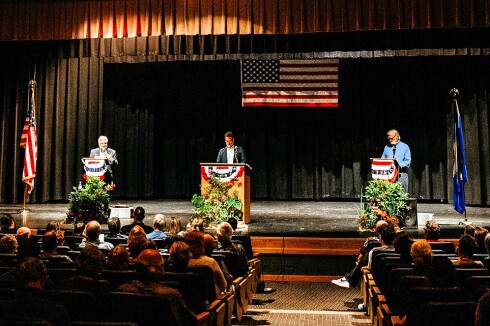Len Anderson says you don't have to be a scientist to see what the big deal is with sulfate. Just paddle a canoe on the St. Louis River.
"Upstream of where the Partridge River flows in, the St. Louis is choked with wild rice," said Anderson, a retired Cloquet science teacher and self-described river rat. "But downstream from the Partridge, there's a 120-mile dead zone on the St. Louis River. There isn't one stem of wild rice."
ADVERTISEMENT
The difference, Anderson and others say, is the amount of sulfate in the water.
Up where mining has little influence on the river, sulfate levels are below 10 parts per million, and wild rice thrives. But where tributaries carry mining runoff into the St. Louis, sulfate levels jump, and wild rice fades away.
Anderson's theory has become the focal point in one of the state's most heated environmental issues in decades.
The state currently upholds the 10 parts-per-million standard as the litmus test for industrial runoff into wild rice waters. But a battle over how much sulfate is too much for wild rice rages among Minnesota lawmakers, the courts, state and federal regulators, the mining industry, the Minnesota Chamber of Commerce, tribal leaders and environmental groups.
The outcome could determine how much new mining occurs in northern Minnesota -- or at least how fast it occurs and how expensive it is. With projects such the PolyMet copper mine advancing through the state permitting process and expansions planned at all existing taconite operations, billions of dollars and thousands of jobs are at stake.
So is the health of wild rice -- manomin -- a sacred staple for Ojibwe people. In addition, wild rice is an important part of the Minnesota ecosystem, feeding waterfowl and people and serving as an indicator of the health of Northland waters.
Moving through the Legislature right now are bills that would raise the sulfate standard to 50 parts per million, or higher. The House and Senate late last month passed different version of the omnibus environmental finance bill that now is in conference committee. Gov. Mark Dayton has not indicated his stand on the issue but has warned lawmakers not to include controversial policy changes in finance bills.
ADVERTISEMENT
"That is an example of policy in a budget bill that the governor is opposed to,'' Katharine Tinucci, the governor's spokesman, told the News Tribune, although Tinucci said the governor has made no promise to veto the sulfate bill.
PolyMet officials have repeatedly said they will meet the 10 parts-per-million standard if necessary, though they agree the standard should be changed.
But the mining industry's biggest supporters, Iron Range lawmakers, aren't as sure the PolyMet project can meet the current standard, and they want to change it. Rep. Tom Rukavina. DFL-Pike Township, says other mining projects, such as expansion of the Mesabi Nugget operations to mine taconite, also might not pass the 10 parts-per-million test.
"Everyone wants to do what's right for wild rice," said Craig Pagel, executive director of the Minnesota Iron Mining Association. "But we need to find out what that number really is. We understand the significance it has for the tribes and for wildlife. But there's no good data now on exactly what's right."
Others, like Anderson, point to scientific research conducted 60 years ago showing that sulfate was clearly detrimental to wild rice above 10 parts per million.
"Some people say there is no science on wild rice and sulfate. There's plenty of science," Anderson said. "They just don't happen to agree with it."
'Sulfate always stuck out'
ADVERTISEMENT
Sulfate is a mineral salt containing sulfur that can come from decaying plants and animals as well as from industrial processes such as mine discharges, tanneries, steel mills, pulp mills and textile plants. High sulfate levels in water are known to damage plants and are suspected of damaging seeds and roots, which are critical for re-growth of wild rice.
Anderson cites extensive research by Minnesota Department of Natural Resources scientist John Moyle, conducted 60 years ago, that documented the relationship of high sulfate levels with poor wild rice development. Moyle concluded that, with some exceptions, wild rice didn't thrive at sulfate levels above 10 parts per million.
"When all of the other variables were the same, sulfate always stuck out as the indicator," said Anderson, who as a young field researcher helped Moyle conduct the work.
In 1973 Minnesota adopted the 10 parts-per-million standard for wild rice production waters. State regulators are supposed to enforce it for any discharge into those waters.
Moyle's peer-reviewed and published research has come under scrutiny in recent months. The Minnesota Chamber of Commerce, the state's largest business group, filed a lawsuit in December asking that the 10 parts-per-million standard be scuttled. The Chamber cites studies in other areas of the state that show wild rice can grow in higher sulfate levels. Indeed, the state issued Minnesota Power a permit for sulfate up to 25 parts per million for a coal-fired power plant on the Mississippi River near Grand Rapids.
The Chamber also claims the PCA has only recently been applying the standards, and only on mining projects, which the group says is "arbitrary and capricious." If applied equally, the higher standards could even shut down several municipal treatment plants, the Chamber notes in its still-pending lawsuit.
State lawmakers are going even further. Their legislation would raise the sulfate standard to 50 parts per million or higher and then order a new study of the relationship between sulfate and wild rice, all while preventing state regulators from enforcing sulfate standards previously on the books.
ADVERTISEMENT
State doesn't have the last word
Whatever the state does with sulfate limits, however, may be moot. The federal Environmental Protection Agency last year asked Minnesota regulators and PolyMet how they plan to meet the original 10 parts-per-million sulfate standard. And state officials say the EPA, based on the federal Clean Water Act, isn't likely to approve a revised state standard without science to back it up.
But that science could take years, and mining supporters don't want to wait. John Pastor, a University of Minnesota Duluth scientist who has studied wild rice in recent years, said lawmakers are trying to force science to comply with their politics.
"Minnesota already has a pretty good sulfate standard with sound science behind it,'' Pastor said. "If you wanted to err on the side of caution, if you want a protective standard for wild rice, 10 parts per million is a good standard. Leave it alone."
Pastor is ready to take another look at the issue. He's part of a team of University of Minnesota researchers at both the Duluth and Twin Cities campuses called together by University President Robert Bruininks. They stand ready to take another look at sulfate and wild rice standards with a grant from the Legislature through the PCA.
Pastor said researchers may indeed find that 10 parts per million is a good standard for some waters, whereas rice in other lakes and rivers could withstand higher sulfate levels. He said he can use big tanks to test sulfate levels with different wild rice in different sediments to match natural conditions.
But Pastor said there's no way scientists can provide valid answers within a year or even two -- the time frame mining supporters have set to develop a new standard so projects can move forward quickly.
ADVERTISEMENT
"I would say six years, minimum -- unless you're going to tell me in advance what the results are," Pastor said, "and that seems to be what the IRRRB and the politicians want."
Pastor said, for example, that it might be obvious that wild rice begins to suffer in one year at 300 parts per million, but not at 50 parts per million. "But what if, after five or six (growing) seasons, we see that 50 parts per million over time is just as bad as 300?" he said. "You can't get valid answers overnight."
Meanwhile, the Fond du Lac Band of Lake Superior Chippewa has federal authority to enforce the Clean Water Act within its reservation, including on the 23 miles of the St. Louis River that runs through it. The band has essentially the same power as the state to regulate water quality in the river on behalf of the EPA.
"We're already looking at sulfate and rice and the impacts here," said Nancy Schuldt, Fond du Lac Natural Resources water program coordinator. "We have been for some time; we're way ahead of the state on that. We aren't ready to publish our research just yet. ... But it's safe to say that we're seeing some adverse impacts on rice with sulfate levels above 10.''
Even if the state raises its sulfate limit, Fond du Lac's is likely to remain at 10 parts per million. And the river running through the reservation already is in violation, probably due to mining impacts, Schuldt said.
"We've been studying sulfate since 2005 and we're consistently seeing numbers from 15 to 40'' parts per million, Schuldt said, noting that upstream permits on the river would have to meet the tribal standard.
ADVERTISEMENT









